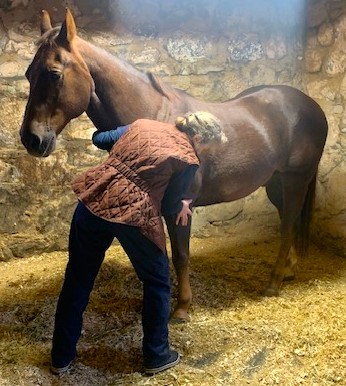Unlocking the realm of Equine Massage Therapy reveals a plethora of techniques, each with its unique benefits catered to address the diverse needs of our equine companions.
Swedish massage: Known for its gentle, flowing strokes, Swedish massage is a popular choice for horses as it promotes relaxation and improves circulation. Swedish massage is not only soothing but also helps in reducing stress and tension, benefiting both the physical and mental well-being of the horse.
Deep tissue massage: For horses with chronic tension or muscle tightness, deep tissue massage is often recommended. This technique focuses on reaching the deeper layers of muscle tissue to release tension and alleviate discomfort. By applying firm pressure and slow strokes, deep tissue massage helps to break down adhesions, alleviate discomfort and restore mobility to stiff muscles, unveiling newfound freedom of movement.
Sports massage: Just like human athletes, horses can benefit from sports massage to enhance performance and prevent injuries. Sports massage targets the specific muscle groups that are engaged during athletic activities, helping to improve flexibility, range of motion, and muscle tone. By addressing areas of tension and fatigue, sports massage can also speed up recovery time after intense workouts or competitions.
Myofascial release: Connective tissue, known as fascia, plays a vital role in the horse’s movement and flexibility. The fascia is a dense connective tissue that surrounds muscles, bones, and organs. Myofascial release aims to release tension within the fascia, improving mobility and reducing pain. The technique involves applying sustained pressure to areas of restriction, allowing the fascia to lengthen and relax and this helps horses regain optimal movement patterns. Unraveling the intricate network of fascia, myofascial release unlocks the key to fluid movement, liberating the horse from restrictions and empowering it with newfound suppleness and grace.
Acupressure: Based on the principles of Traditional Chinese Medicine, Acupressure stimulates healing and balance by applying pressure to specific points on the body, benefiting circulation, pain relief, and overall well-being. Embarking on a journey of ancient wisdom, Acupressure taps into the body’s energy channels to alleviate a wide range of issues, from musculoskeletal pain to digestive disorders, restore equilibrium to the horse’s entire being.
Trigger point therapy: Trigger points or knots, are areas of hyperirritability within muscle tissue that can cause referred pain and discomfort. Trigger point therapy involves applying pressure to these points to release tension and alleviate pain. By identifying and deactivating trigger points and release adhesions, this technique can help to improve muscle function and restore comfort and normal movement patterns.
Lymphatic drainage: The lymphatic system plays a crucial role in immune function and fluid balance. Lymphatic drainage massage aims to stimulate the flow of lymph fluid, reducing swelling and promoting the removal of toxins and waste products from the body and nurturing the horse’s innate capacity for healing and renewal. This gentle, rhythmic massage technique can be beneficial for horses recovering from injury or surgery, as well as those with lymphatic congestion or edema.
Neuromuscular Therapy: This specialized technique focuses on the relationship between the nervous system and muscles. By addressing neurological imbalances and muscle dysfunction, neuromuscular therapy can aid in pain relief, improved movement, and overall muscle function in horses. Bridging the realms of mind and body, neuromuscular therapy orchestrates a symphony of harmony, addressing neurological imbalances to restore vitality, vigor, and balance to the horse’s entire being.
Cranio-Sacral Therapy: This gentle technique focuses on the cranial bones, spinal column, and sacrum to release restrictions and promote balance within the horse’s central nervous system. By facilitating the body’s natural healing mechanisms, cranio-sacral therapy can address a wide range of issues, including head injuries, TMJ dysfunction, and behavioral imbalances.
Reiki: Originating from Japan, Reiki is a form of energy healing that works on the subtle energetic level to promote relaxation, reduce stress, and support healing. Practitioners channel universal life force energy to the horse through light touch or hovering hands over specific areas of the body, facilitating a deep sense of peace and well-being.
Bowen Therapy: Named after its creator, Tom Bowen, this gentle and non-invasive technique involves precise rolling movements over muscles, tendons, and ligaments to stimulate the body’s innate healing response. Bowen therapy can help relieve muscular tension, improve range of motion, and promote overall balance and well-being in horses.
Equine Touch: Developed by Jock and Ivana Ruddock, Equine Touch is a hands-on bodywork technique that focuses on balancing the horse’s energy system, muscles, and soft tissues. By applying specific sequences of moves, Equine Touch practitioners aim to release tension, improve circulation, and support the body’s natural ability to heal itself.
Stretching and Mobilization: In addition to massage techniques, incorporating stretching and mobilization exercises into a horse’s wellness routine can help improve flexibility, range of motion, and overall musculoskeletal health. This may include gentle stretching of limbs, neck, and back, as well as passive mobilization techniques to encourage joint mobility and suppleness.
Hydrotherapy: Hydrotherapy involves the use of water in various forms, such as cold or warm water therapy, swimming, or underwater treadmills, to promote healing, reduce inflammation, and improve overall fitness in horses. Hydrotherapy can be particularly beneficial for rehabilitation from injuries, as well as for conditioning and maintaining musculoskeletal health.
Magnetic Therapy: Utilizing the principles of electromagnetic fields, magnetic therapy involves applying magnetic fields to specific areas of the horse’s body to promote healing and reduce pain and inflammation. Magnetic blankets, wraps, and boots are commonly used to deliver magnetic therapy to enhance circulation, stimulate cellular repair, and accelerate healing.
Each horse is unique and may benefit from a combination of different massage techniques. By tailoring the treatment to the individual horse’s needs, Equine Massage Therapists can help to improve performance, reduce pain, and enhance overall well-being. From the show ring to the sanctuary of the stable, integrating regular Massage Therapy into the horse’s care regimen enriches their journey with vitality, resilience, and a profound sense of holistic harmony.






